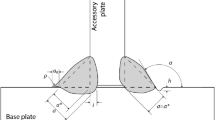Abstract
In high temperature metal forming processes, strong mechanical and thermal cyclic loads coexist in the formed material and in the tooling. Such a phenomenon has a negative influence in the tool life cycle. The thermal and mechanical ranges lead to the appearance of cracks on the tool surface because of thermo-mechanical fatigue damage (TMF). The objective of this paper is to present a simplified cumulative thermo-mechanical fatigue model which has been developed in order to study the most critical areas in the forming tools according to the predicted number of cycles up to crack appearance considering multi-axial fatigue and oxidation. This model is based on assumptions of a general cumulative TMF model proposed by Neu and Sehitoglu; and critical plane approaches by Smith, Watson and Topper, and Fatemi and Socie. In general, cumulative TMF approaches three agents are considered: multiaxial-fatigue, oxidation and creep. The developed model has been applied to a specific manufacturing process of seamless steel pipes which includes three basic forming steps: backward extrusion, perforation and Pilger rolling mill. This process transforms a blank, or ingot, into a final seamless steel pipe with specific dimensions and characteristics depending on market requirements. These studies have been carried out in order to improve the tool life. To this end, the forming process has been reproduced by means of coupled thermo-mechanical FE simulations using the ABAQUS/Explicit solver. Moreover, a post-processing subroutine has been incorporated which enables to predict the number of cycles until crack appearance (tool life) according to both the general model of Neu and Sehitoglu, and the specific model developed. Good correlations between predicted and actually observed damage areas have been reached in both cases. The advantage of the hereafter proposed TMF model is that, it takes the most convenient features of general TMF models and it is particularized to a reduced input TMF model in order to analyze high temperature metal forming processes.









Similar content being viewed by others
References
Remy L, Petit J (2002) Temperature-fatigue interaction, vol 29. European structural integrity society, Elsevier Science
Neu RW, Sehitoglu H (1989) Thermomechanical fatigue, oxidation, and creep, part i, damage mechanisms. Metallurgical transations A. Phys Metallur Mater Sci 20:1755–1767
Neu RW, Sehitoglu H (1989) Thermomechanical fatigue, oxidation, and creep, part ii, damage mechanisms. Metallurgical transations A. Phys Metallur Mater Sci 20:1755–1767
Miller MP, McDowell DL, Oehmke RLT, Antolovich SD (1993) A life prediction model for thermomechanical fatigue based on microcrack propagation. ASTM STP 1186:35–49
Manson SS, Halford GR, Hirschberg MH (1971) Creep-fatigue analysis by strain-range partitioning. In: Curran RM (ed) Proceedings, ASME-MPC3 symposium on creep-fatigue interaction. American Society of Mechanical Engineers, New York, pp 12–28
He J, Duan Z, Ning Y, Zhao D (1983) Strain energy partitioning and its application to GH33A nickel-base superalloy and 1Cr-18Ni-9Ti stainless steel. In: Proceedings of ASME international conference on advances in life prediction methods, New York, pp 27–32
Bernstein HL, Grant TS, McClung RC, Allen JM (1993) Prediction of thermal-mechanical fatigue life in gas turbine blades in electric power generation, thermomechanical fatigue behavior of materials, ASTM STP 1186. In: Sehitoglu H (ed). American Society for Testing and Materials, Philadelphia, pp 212–238
Oudin A, Lamesle P, Penazzi L, Le Roux S, Aria R (2002) Thermomechanical fatigue behaviour and life assesment of hot work tool steels. Eur Struct Integ Soc 29:195–201
Minichmayr R, Riedler M, Winter G, Leitner H, Eichlseder W (2008) Thermo-mechanical fatigue life assesment of aluminium components using the damage rate model of Sehitoglu. Int J Fatig 30:298–304
Smith RN, Watson P, Topper TH (1970) A stress-strain parameter for the fatigue of metals. J Mater 5:767–778
Fatemi A, Socie DF (1988) A critical plane approach to multiaxial fatigue damage including out-of-phase loading. Fat Fract Eng Mater Struct 11:149–166
Socie D, Socie B (2007) Thermomechanical fatigue made easy. In: the 6th Engineering society international conference on durability and fatigue. Cambridge
Zineb A, Abdellatif K, Mata F (2010) Effect of cycle duration and phasing on thermomechanical fatigue of dog-bone specimens made from steel. Amer J Eng Appl Sci 3:740–748
Boismier DA, Sehitoglu H (1990) Thermo-mechanical fatigue of MAR-M247, part 1, experiments. J Eng Mater Technol Trans ASME 112:68–80
Sehitoglu H, Boismier DA (1990) Thermo-mechanical fatigue of MAR-M247, part 2, life prediction. J Eng Mater Technol Trans ASME 112:80–90
Acknowledgments
The authors would like to acknowledge the company Productos Tubulares (PTSAU) for their permission to publish this work.
Author information
Authors and Affiliations
Corresponding author
Ethics declarations
This study was funded by Productos Tubulares (PTSAU). The authors declare that they have no conflict of interest.
Rights and permissions
About this article
Cite this article
Escolán, A., Bielsa, J.M., Hernández-Gascón, B. et al. Thermo-mechanical fatigue approach to predict tooling life in high temperature metal forming processes. Int J Mater Form 10, 535–545 (2017). https://doi.org/10.1007/s12289-016-1299-2
Received:
Accepted:
Published:
Issue Date:
DOI: https://doi.org/10.1007/s12289-016-1299-2




